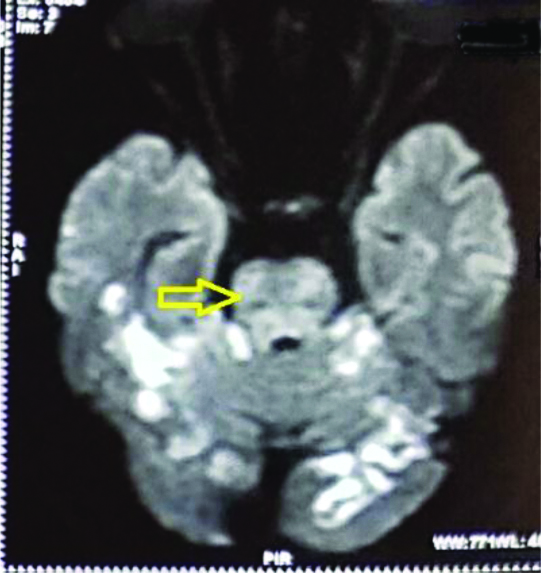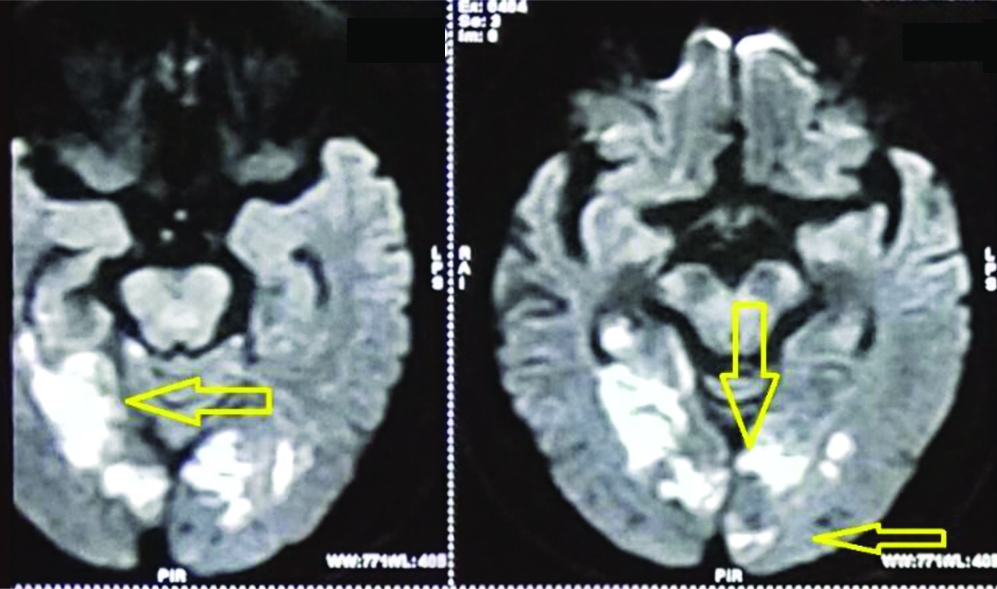Dear Editor,
According to an ancient mythical legend, Ondine, a celestial nymph falls in love and marries a mortal human. Later when she discovers that the lowly human is unfaithful, she bestows a curse on him. This curse is famous as Ondine’s curse which translates into; inability to breath while in sleep, maintaining normal breathing when awake. So the doomed mythical human is destined to die when he falls asleep. As for the scientific paradigm; Ondine’s curse hovers around a medical condition which do exist in form of Central Alveolar Hypoventilation (CAH). Patients having CAH cannot maintain regular respiration and may even go into apnea while in sleep.
CAH is usually a congenital disorder due to a novel mutation of the PHOPX2B gene. Acquired CAH or acquired Ondine’s curse can occur in cases of stroke involving vertebrobasilar artery territory which supplies the brainstem, especially which causes infarct in the lateral medulla. Infarct in the pons may also result in CAH. Locked in syndrome is a condition which occurs in basilar artery strokes involving the pons, where all the voluntary muscles of the body are paralysed except for vertical movements and blinking reflex and the patient remains aware of the surroundings.
This letter is about a 68-year-old male referred from a peripheral private hospital with history of sudden onset of drowsiness and three episodes of vomiting.
There was no history of seizures, diplopia, vertigo, imbalance or fall and head trauma. There was no history of diabetes mellitus or hypertension. Family history was not contributory. He was not taking any medication. There were no similar episodes in the past. Personal history as narrated by his elder son with whom he lived; did not reveal any sleep problems; (insomnia, excessive snoring, increased episodes of day time sleepiness) or bladder/bowel problems.
On examination: His built was ectomorphic. He was drowsy but was responding to verbal stimuli and again was falling asleep. Pulse pressure-110/min, regular, synchronous; blood pressure: 180/100 mmHg right arm supine position, JVP normal, respiratory rate: 8 breaths per minute, SpO2 84%, which improved to 14 breaths/min and SpO2 94% when patient was aroused by calling his name. This phenomenon of bradypnea associated with fall in SpO2 which used to get better with arousal was confirmed by repeated observations.
CNS examination revealed GCS: E3V1M1, Pupils: Bilateral 1 mm reacting to light, there was no gaze deviation, but vertical eye movements and voluntary eye blinking was preserved, suggestive of Locked in state. Motor system; complete quadriplegia, plantars were bilateral extensor.
In view of decreased respiratory drive, airway was secured with endotracheal intubation and patient was ventilated through t-piece. Arterial blood gas revealed hypercapnia (PCo2: 68 mmHG) with respiratory acidosis.
MRI (already done in the first hospital) revealed: early subacute bilateral Posterior Cerebral Artery (PCA) territory infarcts in the bilateral parafalcine parieto-occipital lobes, right medial temporal lobes and right thalamus with gyral haemorrhagic transformation. Early subacute non-haemorrhagic infarcts in the pons and bilateral cerebellum. Loss of flow void noted in the basilar artery and intracranial segment of right vertebral artery, suggestive of thrombus [Table/Fig-1,2]. The probable cause of the ischemic CVE along with thrombus may be attributable to hypertension; which probably existed and was detected with this episode.
Diffusion weighted image of MRI on axial section at the level of brainstem showing early subacute non haemorrhagic infarct in pons and bilateral cerebellum.

Diffusion weighted image of MRI on axial section at the level of brainstem showing bilateral PCA territory infarcts in bilateral parafalcine parieto-occipital lobes.

The patient was treated with IV mannitol, anti-seizure prophylaxis, Aspirin, s/c Low molecular weight heparin.
It was observed that, in aroused state respiratory rate was maintained with normal SpO2, and whenever patient attempted to close eyes and sleep, there was profound bradypnea, hypoxia, hypercapnia features suggestive of Central hypoventilation. The patient was taken on volume control mode but the patient succumbed to aspiration pneumonia after three days without any neurological recovery.
The neural control of respiration in humans is centrally driven to the respiratory muscles through chemical and mechanical inputs [1]. The neural mechanisms of control of respiratory pattern are highly complex and still remains obscure [2-4]. The effect of brainstem disfunction on respiration is usually dependent on the site of lesion in the brainstem, the rapidity of onset of lesion and the basic pathology.
Voluntary/Behavioural/Volitional respiration occurs during wakefulness. This also allows voluntary modulation in the breathing pattern to various operational activities like speaking, straining, breath holding. This control while active during wakefulness becomes quiescent during sleep though; it may be responsible to the chaotic breathing patterns during Rapid Eye Movement (REM) sleep.
This voluntary control is impaired by bilateral lesions in the descending corticospinal or corticobulbar fibers when they traverse through pons and medulla [5]. Vascular lesion in the pons which occurs due to basillar artery thrombosis causes locked in syndrome along with CAH like in this case [5].
Heckmann JG and Ernst S reported a case of 62-year-old male who suffered a fatal symptomatic acquired CAH syndrome caused by megadolichobasilar artery related acute posterior stroke [6]. Long episodes of hypopnea and apnea were observed which responded well to verbal reminders. The patient succumbed after some days. Another report, described a case of CAH due to Wallenberg syndrome [7]. The patient presented with a left lateral medullary ischemic stroke after aneurysm repair and subsequently developed CAH.
Kim MG et al., described another case of posterior circulation stroke in a 59-year-old woman. MRI of the patient showed encephalomalacic changes in both cerebellar hemispheres, the left middle cerebellar peduncle, left pons, and the left anterior and right lateral medulla [8]. This report highlighted the importance of respiratory rehabilitation protocols in management of CAH due to brainstem strokes which improved the prognosis through neuroplasticity.
Unilateral or bilateral lateral tegmental infarcts of pons usually cause impairment to carbon-dioxide responsiveness [6] and lesions in the lateral medulla can cause impairment of carbon-dioxide responsiveness and CAH. Isolated central sleep apnea is associated with bilateral pontine lesions below the origin of Vth cranial nerve in pons down to the tegmental area of the lateral/ventral pons [7].
Infarction of the basal pons which leads to locked in syndrome, is particularly vulnerable for CAH along with lesions in lateral medulla. In patients with brainstem stroke and locked in syndrome associated with bulbar palsy, have a combination of impaired swallowing, CAH, reduced vital capacity and reduced or absent triggering of cough reflex making them highly vulnerable for aspiration pneumonitis and death.
Infarction of the basal pons which leads to locked in syndrome, is particularly vulnerable for CAH along with lesions in lateral medulla [9]. In patients with brainstem stroke and locked in syndrome associated with bulbar palsy, have a combination of impaired swallowing, CAH, reduced vital capacity and reduced or absent triggering of cough reflex making them highly vulnerable for aspiration pneumonitis and death [10].
[1]. Plum E, Neurological integration of behavioural and metabolic control of breathing. In: Parker R, ed Breathing: Hering-Breuer centenary symposium 1970 LondonChurchill:314-26. [Google Scholar]
[2]. Monteau R, Hilaire G, Spinal respiratory neurons Progress Neurobiol 1991 37:83-144.10.1016/0301-0082(91)90024-U [Google Scholar] [CrossRef]
[3]. Richter DW, Mironov SL, Busselburg D, Lalley PM, Bischoff PM, Wilken B, Respiratory rhythm generation; Plasticity of a neuronal network Neuroscientist 2006 6:181-98.10.1177/107385840000600309 [Google Scholar] [CrossRef]
[4]. Bianchi AL, Denavit-Saubie M, Champagnat J, Central control of breathing in mammals; neuronal circuitry, membrane properties and neurotransmitters Physiol Rev 1995 75:01-45.10.1152/physrev.1995.75.1.17831394 [Google Scholar] [CrossRef] [PubMed]
[5]. Ptterson JR, Grabois M, Locked in syndrome: A review of 139 cases Stroke 1986 17:758-65.10.1161/01.STR.17.4.7583738962 [Google Scholar] [CrossRef] [PubMed]
[6]. Heckmann JG, Ernst S, Central alveolar hypoventilation (Ondine’s curse) caused by megadolichobasilar artery J Stroke Cerebrovasc Dis 2014 23(2):390-92.10.1016/j.jstrokecerebrovasdis.2013.02.00323465843 [Google Scholar] [CrossRef] [PubMed]
[7]. Sivakumar K, Garcha M, Mehta D, Leary MC, Yacoub HA, Central hypoventilation: A rare complication of wallenberg syndrome Case Rep Neurol Med 2018 2018:489482010.1155/2018/489482029755801 [Google Scholar] [CrossRef] [PubMed]
[8]. Kim MG, Sul B, Hong BY, Kim JS, Lim SH, Central hypoventilation syndrome in posterior circulation stroke treated by respiratory rehabilitation: A case report Brain Neurorehabil 2019 12(1):e410.12786/bn.2019.12.e4 [Google Scholar] [CrossRef]
[9]. Stewart J, Howard RS, Rudd AG, Woolf C, Russell RW, Apneustic breathing provoked by limbic influences Postgrad Med J 1996 72:559-61.10.1136/pgmj.72.851.5598949596 [Google Scholar] [CrossRef] [PubMed]
[10]. Askenasy JJM, Goldhammer I, Sleep apnea as a feature of bulbar stroke Stroke 1988 19:63710.1161/01.STR.19.5.6373363599 [Google Scholar] [CrossRef] [PubMed]